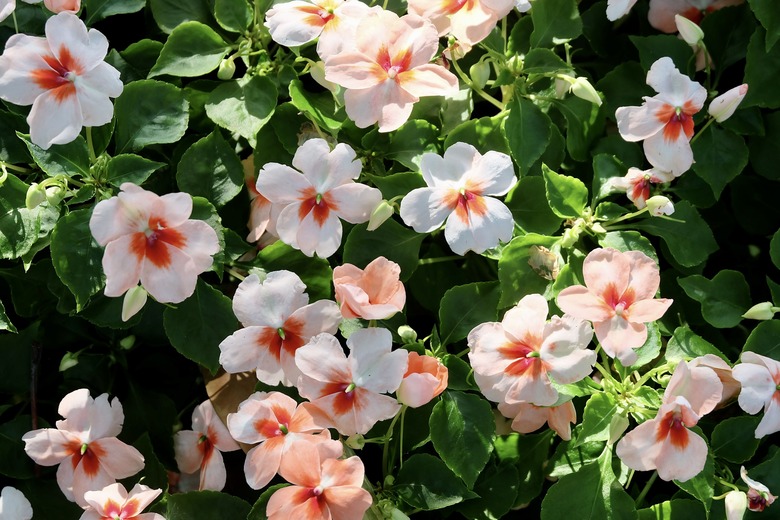What Is Eating My Impatiens?
We may receive a commission on purchases made from links.
Identifying what's eating your impatiens (Impatiens walleriana) leaves is not always obvious, but when you get a positive bug identification, you can start a treatment plan. Impatiens resist major pest infestations, but occasionally, slugs and black vine weevils chew on the leaves. Aphids, thrips, and other sap-sucking insects also affect impatiens by sucking the juice from inside the leaves. Impatiens grow as perennials in U.S. Department of Agriculture plant hardiness zones 10 through 11 but can be treated as annuals and grown in most areas.
Slugs, Weevils, and Cucumber Beetles
Slugs, Weevils, and Cucumber Beetles
Whenever you see large holes in impatiens leaves, you are likely dealing with a slug problem. Slugs move slowly, making them easy to catch, but you have to find them first. They hide during the heat of the day under leaves or on the ground and come out at night. Hunt them at night with a flashlight and pick off any you find. Drop them into a bucket of soapy water. The soap kills the slugs, making them easier to eliminate. The other alternative is squishing, which is an unpleasant task.
When you find holes in impatiens leaves that look jagged and slugs aren't to blame, look for 1/4- to 1/2-inch-long black beetlelike insects. Black vine weevils also eat impatiens leaves and flowers. Catching these pests requires a nighttime trip to the garden with a flashlight. Crush any you find. Also keep an eye out for the white wormlike larvae on the leaves.
Cucumber beetles leave small, round holes in impatiens flowers. Look for yellow beetles covered with black spots or stripes feeding on the flowers. While pesticides aren't an option for this beetle, you can pick them off by hand. Allowing a few hungry garden spiders to live near your impatiens can help keep cucumber beetles from feasting on your flowers.
Sap-Sucking Insects Affecting Impatiens
Sap-Sucking Insects Affecting Impatiens
While aphids don't chew holes in impatiens leaves, they do suck sap, essentially eating the juicy insides of the leaves. Look for tiny black, brown, green, or white insects in clusters. Yellowing leaves or black sooty mold on the leaves also point to an aphid infestation. Use a ready-to-use insecticidal soap spray as indicated on the product label. Spray the area directly until it is saturated but avoid getting it dripping wet. Reapply once a week until the aphids are gone.
Like aphids, thrips and whiteflies suck sap from impatiens leaves as they feed. Whiteflies are tiny, winged insects, while thrips are small black, clear, or white insects. Control is difficult with both of these pests, as most insecticides don't kill them. Natural predators usually keep these bugs in check outdoors. In a greenhouse or indoors, you may need to introduce natural predators, like ladybugs, to keep things under control. Ladybugs also eat aphids and other sap-sucking insects.
Gardeners can also dislodge the pests in their early stage of development with a strong blast of water or by using a handheld vacuum to vacuum the pests from infected plants. Spraying the entire foliage with a ready-to-use insecticidal soap spray will reduce the population but won't entirely eliminate it, and you'll have to use repeated applications. Use the product as directed on the product label.
